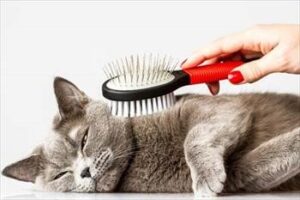
1. START EARLY
It is highly beneficial to get your cat accustomed to grooming from an early age. Establish a routine to avoid any painful encounters for both you and your cat. You’re both more likely to enjoy the quality bonding time that comes with grooming with a happy and relaxed cat.
2. FUR CARE
Short Haired Cats
Equipment You’ll Need: Fine toothed flea/tick comb or bristle brush, rubber mitten or grooming pad, damp cotton or rubber glove.
Your short haired car should only need to be groomed once a week. Use the flea comb to check for flea dirt, then use your fingers to loosen any dead hair. Use a brush or grooming pad to brush from your cat’s head to its tail, removing dead hair and stimulating bloody supply. Remove loose hairs with damp cotton or a rubber glove.
Long Haired Cats
Equipment You’ll Need: Wide tooth comb, rubber mitten or grooming pad.
A long haired car should be groomed once a day. Massaging the skin, check for flea dirt, then use a wide toothed comb to remove any dead hair. Use the rubber mitten or pad to remove excess dead hair and do a final sweep with damp cotton or a rubber glove to remove loose hairs.
Dematting
With any cat, fur matting can be prevented with regular, thorough grooming. If you do find a mat, tease it apart gently with your fingers. Do not be tempted to use scissors as you can quite easily cut your cat.
3. BATHING
As we all know, most cats aren’t particularly fond of water but after a roll around in the dirt or an accident with something sticky, a bath becomes necessary. The first step is to give your cat a good brushing to remove any dead hair or mats. Place a rubber mat in the bottom of your sink or bath and fill it with 7 – 8 centimetres of lukewarm water. Rinse your cat down with a spray hose, taking care not to accidentally spray into the ears, eyes or nose. Massage cat specific shampoo in gently, then rinse thoroughly and dry with a warm fluffy towel.
4. NAIL CARE
It is very important that you get your cat used to having its feet touched before you attempt to clip their nails. Spend 1 – 2 weeks performing a daily foot massage. When your cat is comfortable with you handling its feet, begin by appling gently pressure to the top of the foot ad the underside pad, stimulating the nails to come out. Use sharp, high quality cat nail scissors to carefully cut the white tip of the nail. Take care to avoid the quick, a pink vein that can be seen through the transluscent nail.
5. EAR CLEANING
Place a small amount of ear cleaner (check with your vet for a recommendation) onto a clean cotton ball or piece of gauze. Fold the ear back gently and wipe away any debris or earwax. Make sure to lift away dirt and wax rather than rubbing it into the ear and do not attempt to clean the ear canal as it is highly likely you will cause serious damage.
6. TEETH CLEANING
Make sure you get your cat used to the idea first, start by massaging its gums until it is comfortable having your hands near and in its mouth. Once your cat is comfortable, introduce cat formulated toothpaste by applying it to the lips so your cat gets used to the taste. The next step is to introduce a cat toothbrush. Once your cat is 100% comfortable, you can apply toothpaste to the teeth for a gentle brushing.
7. EYE CARE
Wipe away crusty or gunky discharge from the eyes with a damp cotton ball, making sure to wipe away from the corner of the eye.
Make sure to watch for these signs of stress when grooming your cat:
Skin rippling or twitching
Tail swishing
Sharp turn of head
Sudden freezing
Ears flicking or rotating backwards
Swallowing or licking lips
Shaking its head
Growling or hissing
Grooming your cat can prevent health problems, discomfort for your cat and expensive medical bills as well as providing bonding time for you and your pet so make sure you establish a solid routine. If you have any questions or would like product recommendations, don’t hesitate to contact your local VetLove clinic.







